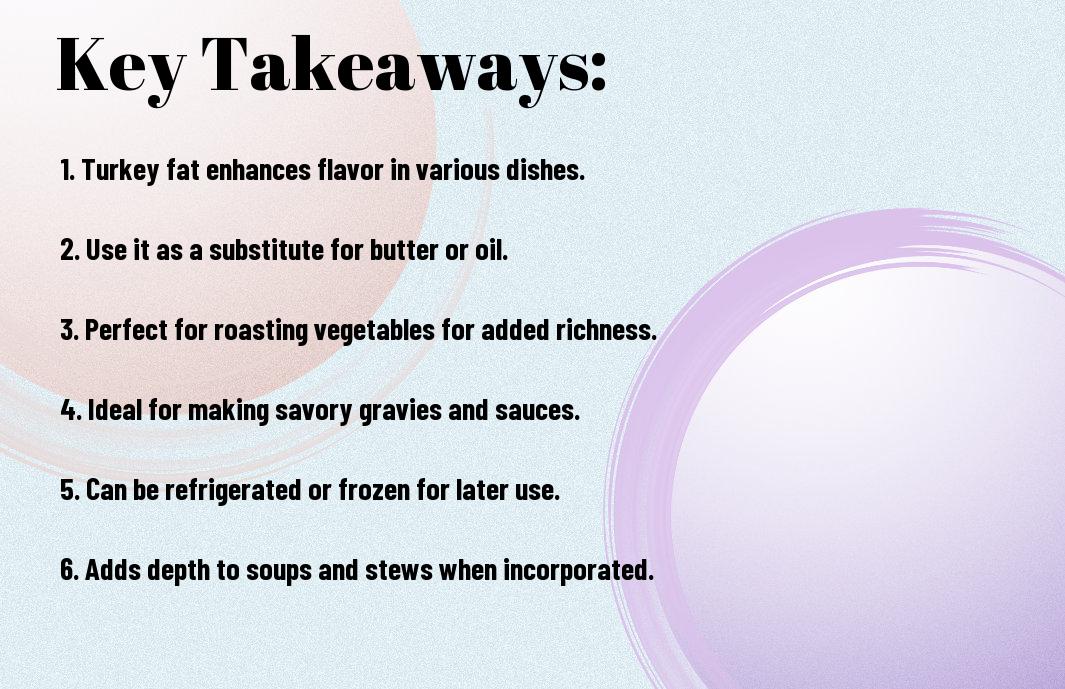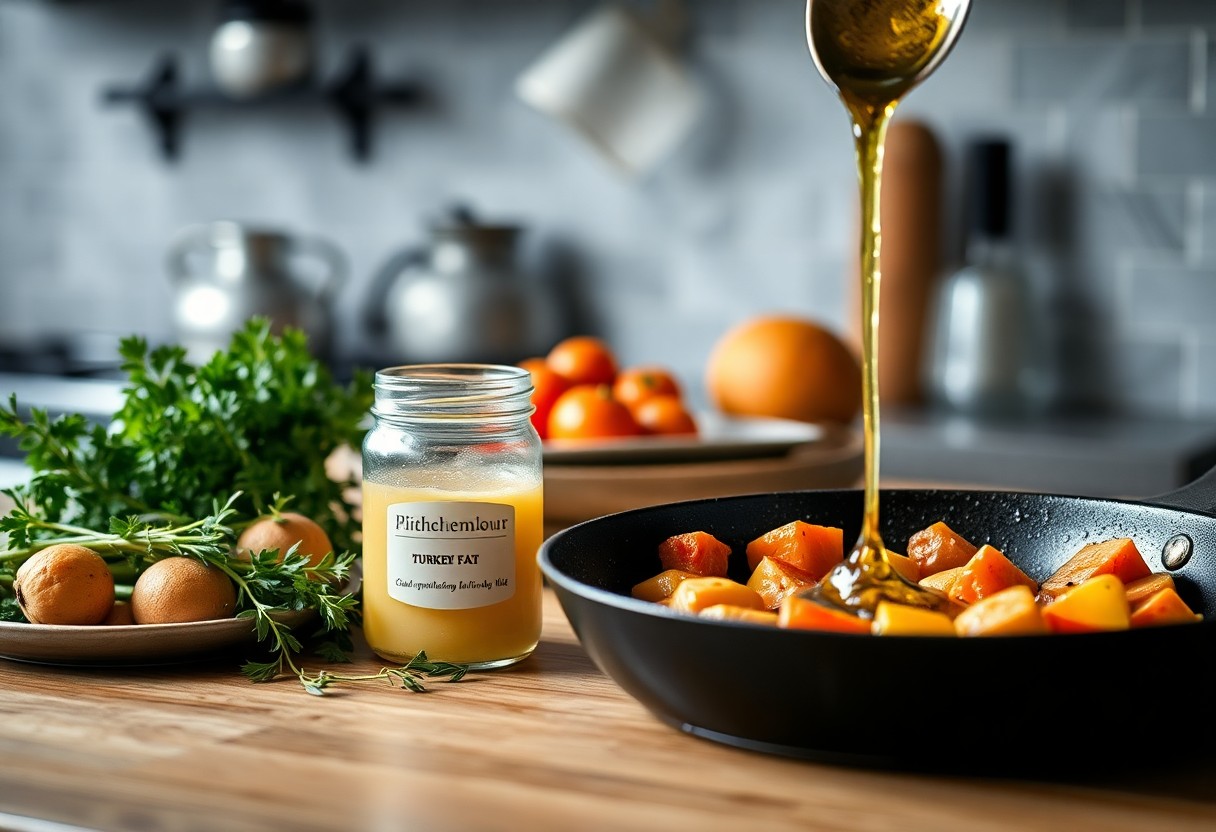Cooking with leftover turkey fat can elevate your culinary creations while maximizing the use of every part of your meal. You’ll discover that this flavorful fat is not just good for frying; it can be a healthy alternative to butter or oil, adding depth to sauces, soups, and roasted vegetables. In this post, you’ll learn innovative methods to incorporate turkey fat into your cooking routine, ensuring you waste less and enjoy more delicious flavors. Embrace this often-overlooked resource and enhance your dishes with its unique taste.
Key Takeaways:
- Turkey fat, or schmaltz, enhances flavor in various dishes, adding richness to items like roasted vegetables and sauces.
- It can be used as a healthier alternative to butter or oil in cooking, imparting a distinct taste while keeping meals moist and tender.
- Leftover turkey fat can be stored in the refrigerator or freezer, making it a valuable ingredient to incorporate into future recipes for added depth and flavor.
Understanding Turkey Fat: What is it?
A unique cooking ingredient, turkey fat, or schmaltz, is the rendered fat from turkey. It is often collected during the roasting process and can be used for various culinary purposes. Rich in flavor, turkey fat provides a distinct taste and texture to dishes, making it a versatile addition to your kitchen. Its buttery quality enhances everything from roasted vegetables to savory pastries, and understanding how to utilize it properly can elevate your cooking to new heights.
Nutritional Profile of Turkey Fat
Below is an overview of the nutritional attributes of turkey fat: it is primarily composed of fat, bringing around 115 calories per tablespoon. Rich in unsaturated fats, it contains healthy omega-6 fatty acids while being lower in saturated fat compared to other animal fats. It also contributes fat-soluble vitamins, like A, D, E, and K, imperative for your overall health.
Traditional Uses in Cooking
One of the oldest culinary practices involves using turkey fat in various traditional recipes, particularly in savory dishes. Many cooks appreciate it as a flavor enhancer and use it for frying or sautéing. Beyond enhancing textures, it can also lend a depth of flavor to gravies, soups, and stews.
Consequently, utilizing turkey fat can transform your dish by adding a rich, savory note that is both comforting and satisfying. Historically, cooks from various regions have embraced turkey fat for its ability to intensify flavors while providing moisture in recipes like potatoes, stuffing, or sautéed greens. It’s worth noting that because turkey fat can have a strong flavor, it’s ideal for dishes that need that extra savory push. When you render your own turkey fat, make sure to store it in a sealed container in the fridge to preserve its quality and avoid spoilage.

Flavor Enhancements: How Turkey Fat Transforms Dishes
If you’re looking to elevate your cooking, incorporating turkey fat may be the game-changer you need. This rich and flavorful fat can enhance the taste of various dishes, giving them a delicious depth that you might be missing. By using turkey fat, you can achieve a savory and inviting flavor profile that transforms ordinary meals into extraordinary experiences.
Gravy and Sauces
Enhancements made with turkey fat can dramatically improve your gravies and sauces. By using it as a base, you’ll achieve a velvety texture and a robust flavor that pairs beautifully with meats and sides. The natural oils in turkey fat meld seamlessly with other ingredients, creating a mouthwatering sauce that complements your dishes perfectly.
Roasting Vegetables
Gravy can add a unique twist to your roasted vegetables when you use turkey fat instead of traditional oils. A quick toss with turkey fat before roasting allows your vegetables to caramelize beautifully, enhancing their natural sweetness while infusing them with a savory flavor. Not only do they gain a nice golden color, but the rich, meaty undertones from the fat will elevate the entire dish. Be sure to use a variety of vegetables, as turkey fat pairs wonderfully with root vegetables while enhancing your overall meal experience.

Cooking Techniques that Benefit from Turkey Fat
To elevate your cooking, incorporate turkey fat into various techniques that enhance flavor and texture. This versatile fat not only adds richness to dishes but also acts as a healthier alternative to other cooking fats. Experimenting with turkey fat can bring a delightful twist to your culinary creations, making them more satisfying and full of depth.
Sautéing and Stir-Frying
Any time you sauté or stir-fry, using turkey fat instead of conventional oils can make a significant difference. It imparts a distinctive flavor while allowing your ingredients to caramelize beautifully. The higher smoke point of turkey fat also means you can achieve that perfect golden-brown finish without worry.
Baking and Pastry Making
An innovative way to use turkey fat is in baking and pastry making. This unique fat can replace butter or shortening in your recipes, creating tender and flaky pastries while infusing them with a subtle, savory richness. Think about using it in pie crusts or biscuits for a delicious surprise that will have your guests raving about your creations.
Further exploring the use of turkey fat in baking opens up new possibilities for flavor combinations in your dishes. Incorporating it can introduce a wonderful depth to your pastries, enhancing their texture while offsetting sweet ingredients. However, be cautious not to use too much; a little goes a long way. The result is a perfectly balanced dish that embodies both savory and sweet notes, providing a truly gourmet experience.
Health Considerations
After exploring the delightful aspects of cooking with turkey fat, it’s necessary to address relevant health considerations. While turkey fat offers a rich flavor and culinary benefits, it’s also high in calories and saturated fat. Overconsumption can impact your heart health and lead to weight gain. Therefore, it’s wise to enjoy turkey fat in moderation and consider how it integrates with your overall diet to maintain balanced nutrition.
Balancing Turkey Fat in a Diet
Above all, balancing turkey fat in your diet involves incorporating it alongside healthier food options. Utilize fresh vegetables, whole grains, and lean proteins to create meals that satisfy your taste buds without excessive calorie intake. Aim for a nutritious plate, ensuring turkey fat complements rather than dominates your meals.
Tips for Moderation
Below are several tips for moderation when cooking with turkey fat:
- Use turkey fat in smaller amounts to enhance flavor in various dishes.
- Combine it with healthier cooking oils for a balanced approach.
- Limit its use in dishes that already contain high-fat ingredients.
- Focus on portion control to manage calorie intake.
Perceiving turkey fat as a flavor enhancer rather than the main ingredient in your meals can lead to a healthier balance in your diet.
Further exploring this topic, here are additional insights on tips for moderation:
- Consider blending turkey fat with spices to maximize taste while reducing quantity.
- Experiment with alternatives, such as vegetable broth, to lighten your dishes.
- Monitor your overall fat consumption from all sources to ensure alignment with your health goals.
Perceiving moderation as a key practice can lead to enjoying turkey fat’s flavor while still being mindful of your nutritional health. Incorporating these tips helps you enjoy your meals without compromising your well-being.

Creative Culinary Uses for Turkey Fat
Despite the common misconception that turkey fat is merely a waste product, it can elevate your cooking in unexpected ways. Utilizing turkey fat, or schmaltz as it’s also known, allows you to add rich flavor and moisture to various dishes. From sautéing vegetables to greasing baking pans, embracing this tasty fat can result in delicious outcomes that surprise your palate.
Home-Made Marinades
HomeMade marinades using turkey fat can transform your proteins into mouthwatering meals. Simply mix turkey fat with your favorite herbs, spices, and acidic components like vinegar or citrus juice. This combination results in tender, flavorful meats that will impress your family and friends.
Infused Turkey Fat
By infusing turkey fat with herbs and spices, you can create a unique flavor base for your dishes. Heat the fat gently with ingredients like rosemary, garlic, or thyme to extract their vital oils, creating a versatile fat for cooking or drizzling.
But you must monitor the heat carefully; too much can burn the fat and ruin its flavor. Once cooled, strain the infused fat into a jar and store it in the refrigerator for up to a month. Using infused turkey fat enhances your dishes with an irresistible depth of flavor, making it a must-have for any culinary enthusiast. It’s not just flavorful, but also highly versatile for sautéing, roasting, or as a finishing oil, so don’t hesitate to explore its exciting possibilities.
Storing and Preserving Turkey Fat
Not only is turkey fat a flavorful addition to your cooking, but storing it properly ensures its longevity and safety. You can maximize its shelf life by following best practices for storage and understanding its safety parameters.
Best Practices for Storage
An airtight container is your best friend when it comes to storing turkey fat. Pour the cooled fat into a glass jar or a food-safe plastic container, leaving some space at the top to prevent overflow as it solidifies. Store the container in the refrigerator for short-term use or freeze it for long-term storage.
Shelf Life and Safety
Below the surface, turkey fat can spoil if not stored correctly. You can typically expect your stored turkey fat to last about 6 months in the freezer and 1 month in the refrigerator. Always check for any off-odors or unusual colors before using it. If it emits a rancid smell or has a strange appearance, do not consume it for safety reasons. Proper storage helps maintain the flavor and quality of your turkey fat, allowing you to enjoy its unique taste without any health risks.
Conclusion
Ultimately, Turkey fat can be a versatile and flavorful addition to your cooking repertoire. You can enhance the richness of your dishes by using it in place of butter or oil, adding depth to sautéed vegetables, or enriching gravies and sauces. By utilizing turkey fat, you not only embrace sustainable cooking practices, but also elevate your meals with unique flavors that your family and friends will appreciate. So, the next time you prepare turkey, consider saving that fat and experimenting with it in your culinary creations.
FAQ
Q: What is turkey fat, and how is it derived?
A: Turkey fat, commonly known as schmaltz when referring to chicken fat, is the rendered fat obtained from cooking turkey. It is typically collected during the roasting process as the turkey cooks and releases fat from its skin and tissues. This flavorful fat can be used in various cooking applications, enhancing the taste of many dishes.
Q: How can I use turkey fat in my cooking?
A: Turkey fat can be utilized in several culinary ways. It is excellent for sautéing vegetables, frying eggs, or making gravies and sauces. You can also mix turkey fat into mashed potatoes for added richness or use it in place of butter or oil in baked goods to instill a unique flavor. Moreover, it works well for greasing baking pans or for use in pie crusts.
Q: Is turkey fat healthier than other fats?
A: Turkey fat contains a higher percentage of unsaturated fats compared to some other cooking fats, which may make it a healthier option when used in moderation. It also provides a distinct flavor and can be a better alternative to more processed fats or oils. However, like all fats, it should be used mindfully, considering your overall dietary fat intake.
Q: Can turkey fat be stored, and what’s the best way to preserve it?
A: Yes, turkey fat can be stored for later use. After rendering the fat, allow it to cool, then strain it through a fine mesh or cheesecloth to remove any solid particles. Store the fat in an airtight container in the refrigerator for up to a month or freeze it for long-term storage. Always label and date your container for easy identification.
Q: Are there any dishes that particularly benefit from the use of turkey fat?
A: Various dishes can benefit significantly from turkey fat. For instance, homemade stuffing or dressing takes on enhanced flavors when cooked with turkey fat. It also elevates leaf greens like collards or kale, providing a savory depth. Additionally, roasted root vegetables tossed in turkey fat before baking can develop a crispy exterior while remaining tender inside.
